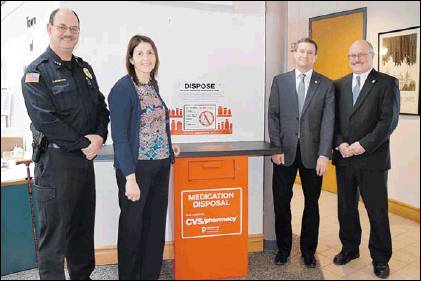Niskayuna installs drug drop-off box at Town Hall
BY KRISTIN SCHULTZ Gazette Reporter
NISKAYUNA — For the past six years, Niskayuna has participated in the National Prescription Drug Take-Back Days typically held in April and October. On Feb. 16, the town installed a permanent drug drop-off receptacle in the rotunda in Town Hall.
“Our take-back events have been very successful,” said councilman Bill McPartlon. “Now, because of the box, people don’t have to wait for the event. People can drop off any time.”
Anyone — not just Niskayuna residents — can dispose of unwanted, unused or expired medications during town business hours. There is no paperwork to fi ll out and identifi cation need not be presented.
“We wanted it not to be intimidating,” said Kristin Sweeter, grant manager for Niskayuna Community Action Program. “It’s in the Town Hall, where people come to pay the water bill or tax bill anyway. It might be intimidating for some people if they had to go to the police station.”
The Police Department submitted an application to CVS Pharmacy for the collection box through the company’s Medication Disposal for Safer Communities program. Through the program, the unit itself came at no cost and N-CAP has pledged to cover the ongoing cost of operating the box including installation, maintenance and disposal fees. Sweeter has set aside around $3,000 per year for the drop box costs.
While some of the disposed medicine may be as mild as aspirin, at past collection days, volunteers have seen more serious drugs like fentanyl patches dropped off. To make sure the drugs stay secure until transported for disposal, the collection unit itself is secured both to the fl oor and the wall. The security cameras already operating in the rotunda also cover the area in which the box is located. Deposits are made through a drop door similar to a mailbox or library book return, so no one could reach into the unit.
Upon collection, police offi cers access the discarded drugs through a locked door on the box. To dispose of the medicine, two offi cers — usually the evidence custodian and the detective sergeant — drive to a Wheelabrator energy-from-waste facility where the material is incinerated and electricity is generated.
Responsible disposal of prescription and over-the-counter medications serves two primary purposes: reducing amount of pharmaceutical material in the water supply and reducing the likelihood that drugs fall into the hands of youths or addicts.
“We partially attribute low use of opioids at the high school to the take-back efforts,” said Sweeter. “Working together is crucial to educate the public and keep our community safe.”
N-CAP released results of its student survey in December. The survey showed that alcohol and marijuana were the most common drugs used among Niskayuna middle- and high-schoolers, unlike other areas in New York and neighboring states that are wrestling with opioid and heroin epidemics.
The town will continue to sponsor take-back days and provide opportunities for the community to learn about proper, safe disposal of unused or expired medications. For those who cannot go to the Town Hall or take-back day, N-CAP also offers drug deactivation bags, which dissolve the drugs and make them useless.
In April 2016, Niskayuna hosted a prescription drug drop-off day that saw 220 people dispose of unwanted medication in just four hours. A total of nearly 400 pounds of medication was collected.
